Horizontal Directional Drilling (HDD) has revolutionized the construction and utilities industry, offering a smarter way to install underground pipes, cables, and conduits. Unlike traditional methods that require extensive digging, HDD offers a trenchless solution that brings significant benefits. Let’s dive into five distinct advantages of this game-changing technology.
1. Minimal Surface Disruption
One of the best things about horizontal directional drilling is that it requires little to no surface disturbance. Unlike open-cut excavation, which tears up roads, landscapes, and driveways, HDD operates underground with precision. This is especially helpful in urban areas where disruption can cause traffic jams or inconvenience to communities.
Moreover, HDD is a friend to the environment. It avoids the need to destroy vegetation or dig up large patches of land. This makes it the ideal choice for projects in sensitive areas like parks, wetlands, or near water bodies. By preserving the surface, HDD ensures a smaller ecological footprint.
2. Cost-Effective for Long-Term Projects
HDD might seem expensive at first, but it saves money in the long run. Traditional trenching methods often lead to additional costs, such as restoring roads, landscaping, or managing traffic diversions. HDD eliminates most of these extra expenses, making it more economical overall.
Additionally, the speed of HDD means projects are completed faster, which lowers labor costs. Companies also save on repairing or replacing damaged infrastructure because HDD’s accuracy reduces the risk of accidental hits to existing utilities.
3. Versatility Across Different Terrains
HDD shines when it comes to dealing with challenging terrains. It easily drills through sand, clay, rock, or even beneath rivers and highways without requiring massive construction efforts. This flexibility makes it suitable for almost any environment, no matter how complex.
For instance, imagine needing to install a pipeline under a busy highway. Instead of digging up the road and causing chaos, HDD allows the installation to happen underground with minimal disruption. This ability to adapt to tough terrains is what sets HDD apart from traditional methods.
4. Reduced Installation Time
Time is money, and HDD saves plenty of it. Traditional digging and trenching methods take weeks, sometimes even months, to complete. HDD speeds up the process significantly because it doesn’t require large-scale excavation or lengthy restoration efforts.
This fast turnaround time makes HDD a preferred choice for utility companies working on tight deadlines. It ensures that new systems are up and running quicker, reducing delays and meeting customer demands efficiently.
5. Safer for Workers and Communities
Safety is a priority in any construction project, and HDD delivers on this front. Traditional trenching often exposes workers to risks such as cave-ins, heavy machinery accidents, and open trenches. With HDD, the work happens below ground, reducing the exposure of workers to hazardous conditions.
Communities also benefit from the safety HDD provides. There’s no need for open trenches that could pose risks to pedestrians, children, or pets. It’s a win-win situation where both workers and the public are protected.
Conclusion
Horizontal Directional Drilling isn’t just a new method—it’s the smarter method. With its ability to minimize surface disruption, reduce costs, adapt to tough terrains, speed up installation, and improve safety, HDD is changing how we think about underground construction.
For industries and communities alike, it’s clear that HDD isn’t just a trend; it’s the future. As we continue to prioritize efficiency and sustainability, HDD offers a path that benefits everyone.


